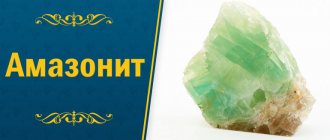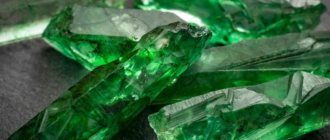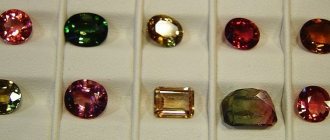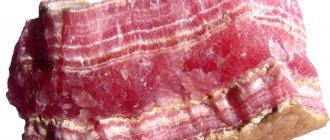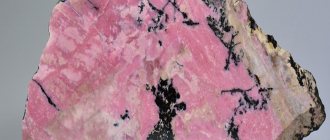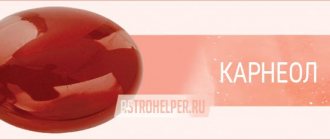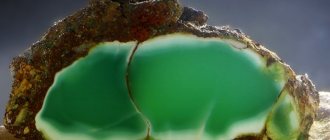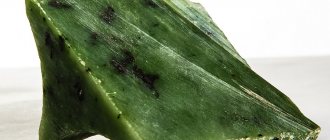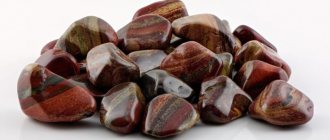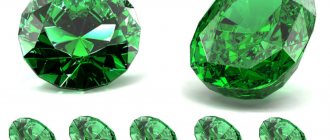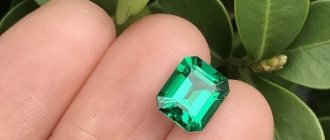| Category | Carbonates (minerals) |
| Title in English | Calcite |
| Formula | CaCO3 |
| Group | Carbonate group |
| Color | White, Colorless, Blue, Yellow, Green, Brown, Red, Orange, Pink, Grey, Black, Blue |
| Stroke color | White |
| Shine | Glass |
| Transparency | Transparent |
| singonia | Trigonal |
| Hardness | 3 |
| Cleavage | Very perfect |
| Density, g/cm³ | 2,71 |
| Kink | Conchoidal |
| origin of name | Calcite got its name thanks to the Austrian mineralogist Wilhelm Haidinger. He used the Latin word calx, which translates to quicklime. Haidinger based his work on the mineral's main industrial significance, namely the production of cement and lime. The mineral calcite is also known by other names. For example, lime spar or andromadas. |
| Morphology | Calcite crystals are naturally flat. Also, there are elongated rhombohedrons, scalenohedra and, less commonly, prisms. It appears in the form of staractites, chalk-like, as well as cocretionary forms or stalagmites. In the natural environment, it is found in the form of granular aggregates. |
The mineral calcite is often found under such names as “dog’s tooth”, “butterflies”, “angels’ wings”. They all differ from each other in crystal shape. The color palette of the mineral is also very diverse, and therefore calcite can safely be called the most diverse stone on our planet. It is very widespread - it ranks third among minerals after quartz and feldspar. It is easy to find even during a regular walk in the mountains. Thus, the Alps and Cordillera are built from calcite.
Calcite deposits
After feldspar and quartz, calcite is the most common mineral on Earth. Large deposits of calcite are located in the United States. Its honey-orange subspecies is mined there. Large crystals up to 6 meters in length were discovered in Iceland. In Russia, calcite deposits have been explored in the Urals and Transbaikalia. Like chalk, the mineral is widespread in the Donbass. Namibia is rich in calcite with the inclusion of malachite, and in the Congo and Morocco there are its combinations with cobalt.
Physical research methods
Differential thermal analysis
The main lines on the x-ray: 3.03(10) - 2.28(7) - 2.09(7) - 1.910(9) - 1.873(8) - 1.600(6) (calcite); 3.57(10) - 3.28(10) - 2.728(10) - 2.062(8) - 1.820(6) - 1.647(2) (vaterite).
Ancient methods. Under the blowpipe it cracks with the release of CO2, i.e. it dissociates into CaO and CO2. The resulting CaO glows brightly and colors the flame orange.
Under the blowpipe. It cracks and releases CO2 (burnt lime).
History of calcite
— Advertising —
Calcite has been known to the Majesty for a very long time, but it attracted attention only in the 17th century, when Iceland spar, one of its varieties, was discovered. Then the official name of the stone appeared, which comes from “calcis”, which is translated from Latin as lime. It is connected with the fact that in ancient times lime was extracted by burning calcite.
People began to build various buildings from calcite a very long time ago, but even now few people know how widespread this mineral is, even though they build houses from it, create sculptures and make food supplements.
Characteristics and varieties of mineral
Calcite is a gem that comes in many varieties and shades. They significantly affect the properties of crystals.
Orange
This gem looks very beautiful. Orange calcite helps balance emotions, cope with fears, and overcome depression.
The gem is especially useful when you need to stop being afraid of something. It will help restore emotional and intellectual balance.
The orange crystal looks very impressive.
White
This mineral helps improve memory and strengthen the inner core. With the help of white calcite, it is possible to bring the possibility of astral travel closer. The gem also strengthens the relationship between the physical body and mind.
Blue
It has calming properties, improves memory, and inspires confidence in its owner. The mineral helps tidy up the nervous system and successfully copes with laziness.
Blue or blue calcite helps with retention of information and is great for students.
Green
Attracts money and success, makes business more successful. This mineral has a beneficial effect on the processes of landscaping and nucleation.
Also, with the help of green calcite, it is possible to sharpen intuition and develop extrasensory skills.
Yellow
Helps develop intellectual abilities and ensures clear organization of the thought process. The mineral also increases energy levels.
The use of yellow calcite increases a person’s personal energy and makes him more significant in his own eyes.
Red
Considered a symbol of excitability. It helps stabilize the power of desire and increases inner strength. This helps you achieve your goals.
The gem also helps to attract love. It allows you to cope with fears and even get rid of them completely.
Pink
It is distinguished by gentle and at the same time strong energy. With its help, you can easily replenish the body's energy reserves.
The stone has a beneficial effect on the state of the heart chakra. It helps fill your heart with love for other people and yourself.
Violet
Helps you become much calmer. With the help of this gem it is possible to dull the active expression of emotions and thoughts. It also helps to adequately cope with serious grief.
Yellow calcite helps develop mental abilities.
Other colors
The properties of calcite directly depend on its shade:
- Transparent - Helps enhance imagination. The mineral allows you to see dual meanings in the actions of other people.
- Gray - the stone brings calm and tranquility. It helps to distance yourself from everyday chaos and increased emotionality. In addition, the mineral reduces the effect of karmic negativity.
- Black - relieves depression, softens grief, helps to adapt to sudden changes.
In general, calcite is a mineral that comes in many varieties. In total, mineralogists describe more than 700 species of rock.
The most common ones include:
- Anthraconite - thanks to the bitumen in its composition, it has a black color.
- Argentina - has a silver color and is distinguished by its plasticity.
- Limestone is a rock in the form of calcite crystals.
- Iceland spar - also called optical calcite. It is a transparent variety that is distinguished by its unique refraction of rays.
- Simbircite has a yellow or red tint and has a translucent structure.
- Marble onyx is considered a decorative and ornamental variety.
- Marble - contains calcium carbonate and natural inclusions of other minerals.
- Travertines are plastic aggregates formed by the remains of ancient fossilized algae.
- Pearl is an aggregate of calcium carbonate and a special horny substance, conchiolin.
- Ophiocalcite is a stone with properties consistent with a fine-grained metamorphic rock. Its structure contains calcite and chrysolite, which contain many inclusions and entire veins of serpentine serpentine.
Anthraconite has a black tint due to the presence of bitumen in the composition.
Physico-chemical characteristics of calcite
Pure, without impurities, calcite is white or colorless, it is transparent or translucent, depending on the crystal structure.
The color range of a mineral is directly related to the presence of certain impurities in its composition. For example, date nickel is green; cobalt and manganese – pink. Fine pyrite gives shades of blue and green. Calcites with iron impurities become yellowish, brownish, red-brown; with chlorite impurities - green. Carbonaceous substances are responsible for the appearance of an uneven black color. In the presence of bituminous substances, a yellow or brown color appears. The specific gravity of calcite crystals is 2.6-2.8 g/cm3, hardness on the Mohs scale is 3, step fracture, perfect cleavage, they have a glassy luster to pearlescent. With dilute hydrochloric acid the stone boils.
— Advertising —
Transparent crystals are characterized by birefringence: if you examine the stem through it, the latter begins to double.
In the event of an impact, the mineral breaks into fragments. When heated to 500°C and at elevated pressure, calcites turn into aragonites, and if they are heated further, they decompose into lime and carbon dioxide.
Physical and chemical properties
Calcite formula is CaCO3. Being a carbon compound, it easily reacts with any acids. Such a reaction will proceed very violently, with the release of huge amounts of carbon dioxide and foam. The mineral can be found in nature either in its pure form or include impurities of various metals: nickel, manganese, iron. It is inclusions like these that determine the color of the rock.
The stone is quite soft and can be scratched easily.
The Mohs hardness of calcite is 3 out of 10, meaning it is considered quite soft. An ordinary needle or pin will easily scratch it. Due to scratches, the mineral easily loses its shine. It is quite easy to distinguish limestone with impurities from pure one. Pure stone is transparent, crystals are visible in it. If you look through it at any object, it will visually become twice as large. This property is called birefringence. The density of calcite is 2.7 grams per cubic centimeter.
Most often, calcite has the shape of a regular figure: rhomboid, prism or octahedron. A mineral that contains large amounts of manganese will appear reddish or pink. Iron makes the stone yellow-brown, malachite makes it green.
The fracture of calcite is conchoidal, that is, it forms a surface shape that resembles mollusk shells. A blow or shock splits it into regular polyhedra. Shine depends on impurities. Most often it is mother-of-pearl or glass.
Types of calcite
There are a huge number of varieties of calcite, which are distinguished by the shape of the crystals and their color. Among the most famous are the following types:
- Iceland spars are transparent calcites, without color, but with very pronounced birefringence.
- Anthraconites are black calcites containing bitumen.
- Simbirtsites are translucent stones, painted in yellow or reddish tones. A monument to this gem was erected in Ulyanovsk (formerly Simbirsk).
- Argentina - a subspecies with a lamellar structure and a silvery tint.
Chemical composition
Calcium oxide (CaO) 56.03%, carbon dioxide (CO2) 43.97%; often forms double salts with magnesium and iron, sometimes manganese, less often with zinc (up to 2%) and strontium (strontiocalcite). Impurities of Mg, Fe, Mn (up to 8%), much less often Zn (up to 2%), Sr (strontiocalcite) and Co, Ba and Pb can replace Ca, but the most significant role in this regard is usually played by the first three elements.
Varieties
Isomorphic impurities are very widely represented. Of the varieties based on physical characteristics, mention should be made of Iceland spar - a colorless, transparent variety of calcite (optical calcite ). It is characterized by double refraction.
Marble onyx is a banded variety of calcite.
Calcite. Replacement of scalenohedral crystals with orthorhombic ones. Russia, Far East, Tetyukhe Field
The magical properties of calcite
Calcite crystals have significant energy potential.
They help to enhance the development of logical thinking and eliminate excessive passion. Amulets and talismans based on calcite are recommended for those involved in business, finance, law and treatment. They make representatives of these areas of activity far-sighted and protect them from mistakes. The calcite talisman will help motorists and professional drivers protect themselves from a traffic accident. It is important that calcites cannot be re-gifted; they are passed on exclusively by inheritance. Before putting on the talisman, it is cleaned by placing it under cool running water, which quickly washes away previously accumulated negative energy from the stone.
How to care for stone
The stone requires care when used: you should not drop it or hit it with anything.
Wash a dirty pebble with warm water and soap or other mild detergent.
Energy cleaning is also needed. Especially if the talisman is present in technogenic zones (in production, on the workshop) or in a conflict team. To do this, a pebble or accessory is kept under running water, after which it is exposed to the sun to “recharge”.
Healing properties of calcite
A positive effect of calcite on the functioning of the human digestive system has been noted, and depending on the color, the mineral has a stronger effect on certain organs. Calcite gives its owner endurance and helps in tolerating high physical exertion. A ring with a gem on the little finger of the right hand or a pendant on the neck helps in the treatment of cardiovascular diseases. Calcite beads in a silver frame are used for colds.
Who suits the name
Ring with calcite
What is known about the compatibility of the energy of the talisman and the owner is that the name also affects the character. The options for the effect of the blue crystal on the following names are given:
- The blue gem gives Leonid spirituality.
- Vasily’s character lacks calmness and peacefulness, the amulet eliminates the deficiency.
- Christina gains financial independence.
- Irina, with the help of an amulet, will cope with the optionality, while maintaining a cheerful character.
- The talisman helps Maria cope with her complexes and makes her believe in her own strength.
- The stone helps Tamara find the right path and achieve prosperity.
In addition to spiritual development, the owner of the amulet finds ways to improve the quality of life, maintain a favorable atmosphere at home and an optimistic attitude at work.
Sectors of application of calcite
Calcite is known as a popular building material.
On its basis, for example, cement and lime are produced. In the chemical industry, the mineral is used in the production of caustic soda, and in the metallurgical industry - as flux. Most varieties of calcite are not suitable for making jewelry because the mineral is too soft, but, for example, satin spar and manganocalcite are used as ornamental materials.
How to distinguish an original from a fake
Crystal Calcite
The price of calcite is not too high, but there are several “buts”. Construction grades are not suitable for decoration. But ornamental and semi-precious crystals can easily be counterfeited. As cheap as they are, the cost of plastic or glass is even lower. So fraudsters make significant profits by passing off counterfeit goods as genuine.
It is especially important to be able to distinguish a fake from a natural stone if you are buying it for treatment or magical practices. In this case, you will be primarily concerned about the energy properties. Calcite, like any other breed, has them only if it is a natural specimen.
The main difference between natural stone and artificial stone is defects. If you look closely at its thickness, you will notice uneven coloring, microcracks, multi-colored inclusions and air bubbles. A fake is always flawless, no matter how paradoxical it may sound.
If you are purchasing Iceland spar, the most popular type of limestone among jewelers, pay attention to how it refracts light. Double refraction is its main and unique property. The mineral acts as a magnifying glass; it is not for nothing that it was previously used to make binoculars and telescopes.
This feature is called optical anisotropy. It is possible to imitate it, but this will sharply increase the cost of a glass fake. It would be unprofitable to sell such a fake for the sake of excess profits.
Calcite colors
The color palette of calcite is very diverse. Most often it is either colorless or has light, delicate shades. Impurities of other elements can give calcites different colors: from lilac to crimson, from green to blue, from honey-yellow to brown. Blood-red coloring appears in the presence of small grains of cinnabar, blue, green, blue - with copper carbonates.
Compatibility with other stones
Calcite is suitable for lovers of products with different types. Transparent, beautiful, non-conflicting material is combined with other minerals and looks like a worthy companion to semi-precious, precious varieties.
The best frame is silver. Gold extinguishes the energy of the mineral, cupronickel absorbs the human aura, preventing spar from interacting with the owner’s biofield.
Calcite combines with different rocks and minerals. There are no undesirable, negative energy combinations.
Spar is a non-conflict stone that can be combined with other rocks
Calcite and zodiac sign
Calcite is a very friendly stone and willingly helps all people, regardless of their zodiac affiliation. The only exception is Scorpio, with which very light calcite does not get along. It is believed that Scorpios are more prone to black magic. Blue calcites are perfect as protective talismans for Cancers, green ones - for Capricorns.
Where is the mineral used?
The scope of application of the crystal is wide. It is used in jewelry, when creating decorative elements and in industry.
Jewelry and decor
Jewelers are wary of this stone. Working with it is troublesome, it is fragile and is afraid of the effects of acid. Nevertheless, there are craftsmen who create beautiful jewelry with calcite. It is used as an insert for rings, pendants, rings and earrings. Necklaces and bracelets with this crystal are considered rare.
Souvenirs are made from multi-colored transparent minerals. Pastel-colored specimens are especially valued by craftsmen.
Other areas
The crystal is used in the manufacture of paper, varnishes and paints. Crushed minerals enriched with silicon are used to purify water from various impurities. Vases and statues are made from them. Previously, the stone was also used in the manufacture of optics.
This is a popular construction and cladding material.
Interesting facts about calcite:
- Calcite is a real record holder for the variety of shapes and colors among all existing minerals. There are more than 700 varieties of it. In the caves there are stalactites and stalagmites made of calcite, beautiful, bizarre-shaped “pearls of caverns” and other aggregates.
- Calcite is one of the ten standard stones, and ranks third on the Mohs scale.
- One of the most beautiful natural structures on our planet, the Great Barrier Reef (Australia), is built precisely from calcite. It reaches approximately 2,000 km in length.
- The ratio between the weight of calcites on the ground and the surface they cover is 1:10. The earth's crust contains about 4% of this mineral, but by area it is 40%.
Origin and location
The formation of calcite is closely related to the geochemical characteristics of calcium and CO2. Calcium is one of the eight essential elements in the earth's crust with a typical lithophilic tendency, and it occurs exclusively as a divalent cation (Ca2+ = 1.05 A).
Calcite is one of the most common minerals in the earth's crust, sometimes composing entire massifs (limestone mountains). This mineral is formed during a variety of geological processes in the form of limestone, chalk and marble. Limestones are chemical or biogenic marine sediments.
Endogenous conditions
Calcium plays an essential role in endogenous formations. It is part of the main rock-forming silicate minerals (plagioclase, hornblende, etc.) and, to a large extent, also in the composition of various carbonates, especially calcite, being released mainly during the hydrothermal stage. Calcite is also formed under magmatic conditions as a result of differentiation of alkaline magma, forming carbonatite bodies. During the early stages of magmatic crystallization, calcium is included in significant quantities in the composition of apatite, and during the hydrothermal process - in the composition of fluorite. In hydrothermal veins, calcite often forms richly shaped crystals of varying habit and is one of the most recent minerals.
1. Among endogenous calcite, noteworthy is the calcite of carbonatites - essentially calcitic rocks containing forsterite, phlogopite, pyroxenes, sometimes magnetite and almost always rare metal minerals: baddeleyite, pyrochlore, perovskite, etc. Carbonatites are spatially and genetically associated with alkaline and ultrabasic rocks, forming complexes of massifs of central type. The origin of at least part of the carbonatites is magmatic, but metasomatic formation is probably also possible.
2. Crystalline formations of calcite of hydrothermal origin are widespread. It is formed in significant quantities in contact metasomatic deposits by redeposition or recrystallization of limestones. In pegmatites it is one of the very last minerals characterizing the hydrothermal stage of the process. It is characteristic that in numerous ore-bearing mainly sulfide vein deposits, calcite, as a rule, is one of the last minerals to crystallize. The same category of formations includes allocations of crystalline calcite in amygdalae and geodes among effusive igneous rocks and deposits of aragonite and calcite from some mineral springs in the form of “calcareous tuff” (due to the rapid release of CO2 from them under the influence of a sharp decrease in external pressure).
Calcite. Biogenic aggregate
Exogenous conditions
Under exogenous conditions, the migration of calcium follows the migration of carbon dioxide, forming soluble bicarbonate, and in this form is carried into marine basins. The deposition of CaCO3 under exogenous conditions often occurs sequentially through various modifications: CaCO3 (gel) - vaterite - aragonite - calcite. Calcite is the most stable modification and often forms paramorphoses after aragonite. Calcium accumulates in the form of calcite, in addition, biochemically by plants and various organisms. Plants extract CO2 from bicarbonate solutions and thus reduce the solubility of calcium carbonate (for example, the formation of travertine), and organisms use CaCO3 to build their shells, which settle to the bottom of the sea after the death of the organism. The solubility of CaCO3 in seawater depends mainly on temperature, partial pressure of CO2, pH and the content of other salts. Cold water, unlike warm water, contains huge amounts of CO2 and therefore can dissolve more calcium carbonate, which explains the precipitation of the latter of the cold streams when they enter warm seas.
3. During weathering processes, calcite, although it does not occur in large accumulations, is observed quite often in the form of new formations in cracks and voids in oxidation zones of ore deposits and rocks. The source for it in these cases is endogenous lime-containing minerals decomposing in the weathering crust and atmospheric carbon dioxide. It should be noted that in general, during the process of weathering of rocks, very significant masses of lime pass into solutions in the form of bicarbonate, which can be transported by flowing waters very far, right up to the sea, unless conditions are encountered along the way that force it to precipitate in the form of crystalline or colloidal carbonate Ca[CO3].
Stalactite formations in limestone grottoes are the result of the precipitation of carbon dioxide from saturated solutions that slowly seep into the hollow spaces. These solutions, when hanging in the form of drops from the ceiling, lose water by evaporation, become highly supersaturated and release colloidal or finely dispersed sediments in the form of sinter masses, which gradually harden and crystallize with further dehydration.
4. Huge masses of Ca[CO3] are formed by sedimentation, especially in marine basins, initially in the form of calcareous silts, dead marine plants and invertebrate animals with a calcareous skeleton. Later, all these substances turn into limestone. Oolitic limestones are most likely formed by the coagulation of colloidal solutions of lime carbonate around grains of sand and gas bubbles suspended in moving water. The modern formation of oolites in marine basins is confined to the coastal shallow zones of tropical and subtropical seas. Initially, these oolites are composed of aragonite, which later turns into calcite. Regardless of how calcite is formed, it is a relatively weakly stable mineral in the weathering crust. Due to its easy solubility in acids, it goes into solutions in the eluvium zone, especially in the oxidation zones of sulfide ore deposits. During exchange decomposition reactions, calcite is often replaced by other minerals (gypsum, dolomite, smithsonite, malachite, etc.):
H2SO4 + CaCO3 + H2O = CaSO4 2H2O + CO2; ZnSO4 + CaCO3 + 2H2O = ZnCO3 + CaSO4. 2H2O, etc.
On the surface of limestones in the zone of groundwater saturated with lime, not only is the deposition of coagulates of iron hydroxides, colloidal silica, etc. often observed, but the limestones themselves are replaced by them. Six stable isotopes of calcium are known: Ca40, Ca42, Ca43, Ca44, Ca46 and Ca48, their abundances are 96, 97, 0.64, 0.145, 2.06, 0.0033 and 0.185%, respectively. There are four more radioisotopes with mass numbers: 39,41, 45 and 49. When studying isotopic fractionation in calcium-containing minerals, especially in calcite of various origins, the ratio Ca44/Ca42 is used, since Ca40 is partially radiogenic and can be obtained as a result of (i-decay K4O).
